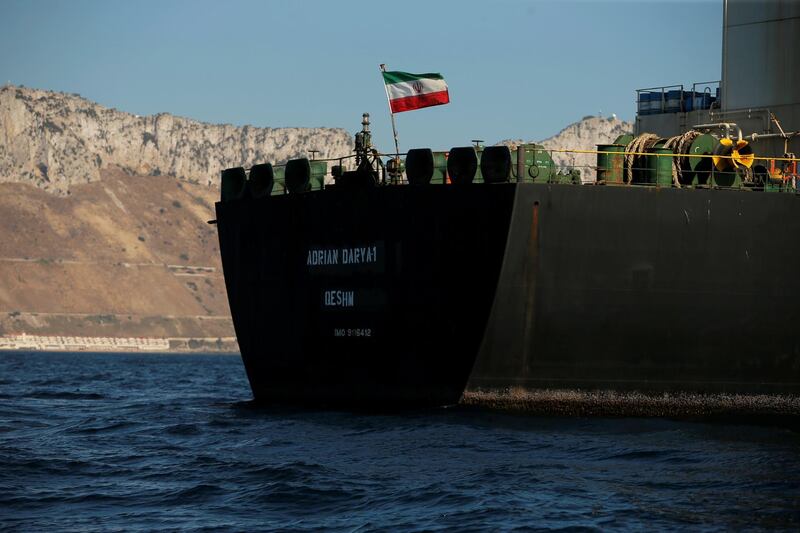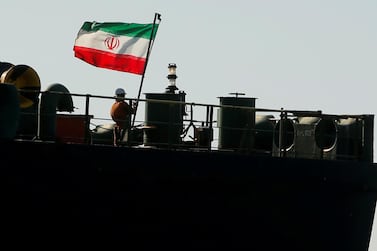Iranian tanker Grace 1, at the heart of a month-long stand-off that involved Tehran, the UK and the US, has weighed anchor, leaving markets to wonder where 2.1 million barrels of sanctioned oil is likely headed.
The vessel swapped its Panamanian flag for an Iranian one and was renamed Adrian Darya 1 prior to its release by Gibraltar, in whose territorial waters it was seized in July by the UK's Royal Marines for carrying crude to Syria.
The ship is currently on its way to the southern Greek city of Kalamata, which has no oil infrastructure or facilities to handle a Very Large Crude Carrier (VLCC) such as Grace 1.
The six-day journey has left traders scratching their heads and serves as an example of Iran’s efforts to get its oil to market since a crippling round of sanctions came into force.
The White House has, since walking away from the Joint Comprehensive Plan of Action, which allowed Iran to access the financial and oil markets in return for compliance with the nuclear deal, vowed to squeeze the country's exports to zero. Its cancellation of waivers at the end of April to eight of Iran's top buyers was set to tighten the noose. However, Iran still managed to export half a million barrels per day (bpd) in May, and 800,000 bpd in July, according to TankerTrackers.com, which has been monitoring satellite data to track Iranian exports.
TankerTrackers.com founder Samir Madani believes that the situation the Grace 1 found itself in was as a result of a botched effort by Iran to undertake ship-to-ship transfer of crude in the relatively safe Syrian territorial waters, just after the cancellation of waivers.
Transfers to other vessels normally take place with the ship’s automatic identification system (AIS) transponders turned off, leaving the vessels in what Mr Madani described as the “digital dark”.
Iranian vessels, particularly, have been known to go off-radar, disappearing for days only to reappear with their storage tanks either partially or fully empty, with other nearby vessels seen moving off laden with crude.
Iran, which has been supplying the Syrian refinery at Baniyas with crude, normally charters the vessels through the Suez. Around 17 million barrels of crude have been delivered to Baniyas over the past year, with 3 million on a monthly basis since May, Mr Madani said.
When the waivers were expiring in May, Iran was faced with the challenge of offloading a huge amount of oil to ensure its production didn't drop.
“And if China is not receiving it, then Syria is receiving it and the fastest way is the two-week trip to Baniyas through the Suez,” said Mr Madani.
However, Grace 1 chose the circuitous route around Africa to eventually reach Syria, where it could safely undertake transfer of crude because Iran needed to gather "small purchase orders, here and there, most likely European customers, if not in the Mediterranean or elsewhere", he added.
With the tanker's voyage cut short after being apprehended off the coast of Gibraltar, Syria no longer looks like the destination for Grace 1, which is likely to head back to Iranian territorial waters. Its return could facilitate the release of the impounded British-flagged Stena Impero seized by Tehran last month.
However, Grace 1 needs to shed at least a million barrels before undertaking a transit through the Suez canal, which cannot handle a vessel loaded with 2 million barrels of oil.
According to Giorgos Beleris, Mena oil research manager at Refinitiv, the tanker is unlikely to use the option of the Sumed Pipeline to offload its crude.
“It may be the case that the Iranians won’t want to use that facility for many reasons, one of which would be that Saudi Aramco is a stakeholder in this pipeline and would bring all sorts of scrutiny on the Iranian cargoes,” he said.
“So they will try and offload half the cargo onto a different vessel and then the vessel can freely cross the canal,” he added.
There are two tankers currently in the Eastern Mediterranean that could fit the bill for a ship-to-ship transfer from Grace 1.
A month before the Iranian ship was apprehended off the coast of Gibraltar, two vessels, a small 350,000 barrel capacity Iranian-flagged carrier as well as a Syrian-owned but Beirut-based ship went offline, according to TankerTrackers.
"Our initial assessment was that Grace 1 was supposed to rendezvous with these two smaller vessels, in order for them to take oil to customers," said Mr Madani.
The National reported last week that a pair of shadowy Lebanon-based companies own and operate tankers illicitly transporting Iranian oil in the Eastern Mediterranean.
For now, Grace 1 has its eyes on the southern Greek port, with Iran unlikely to have its vessels call at an EU port and more likely to explore alternatives to continue exporting oil to customers.








